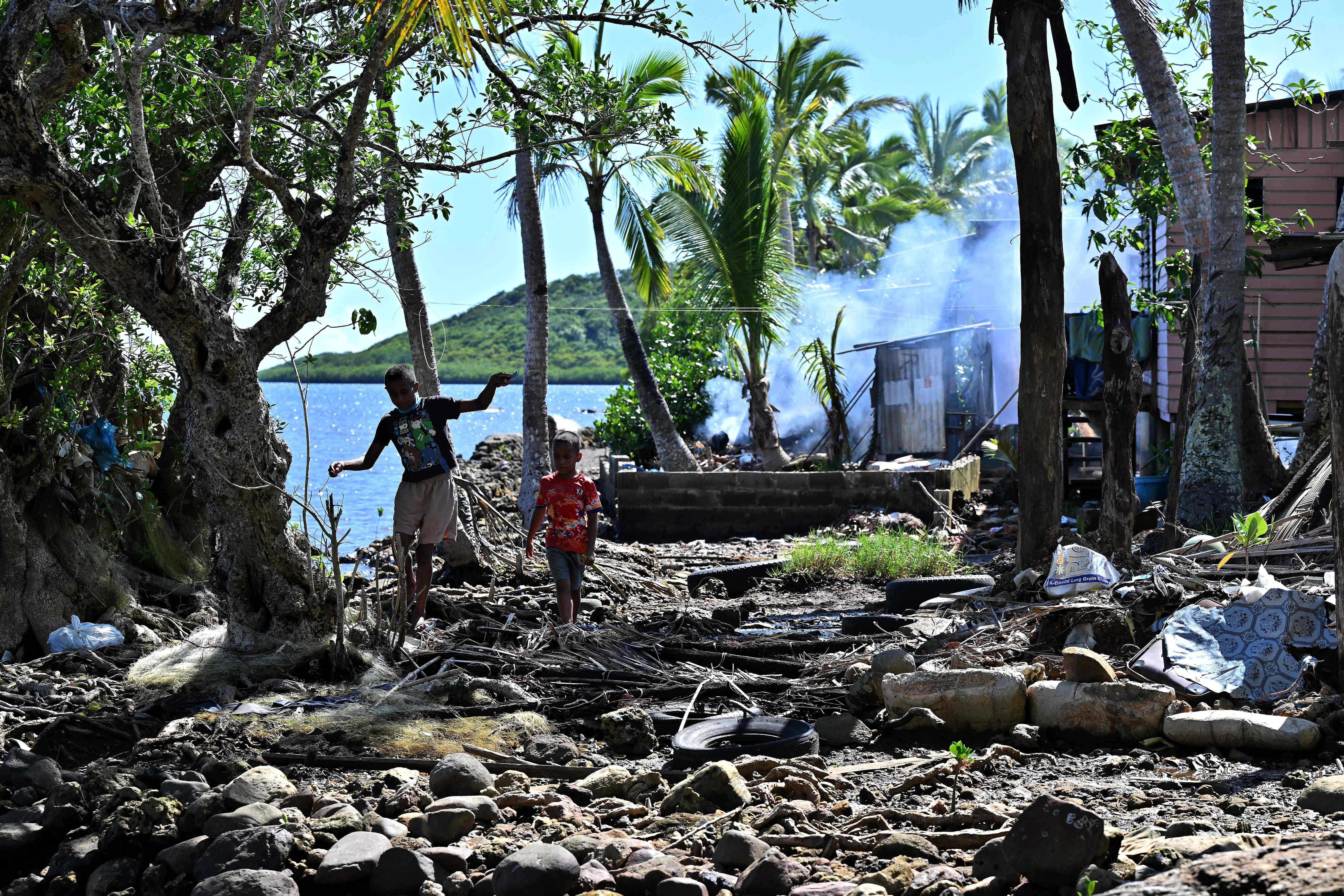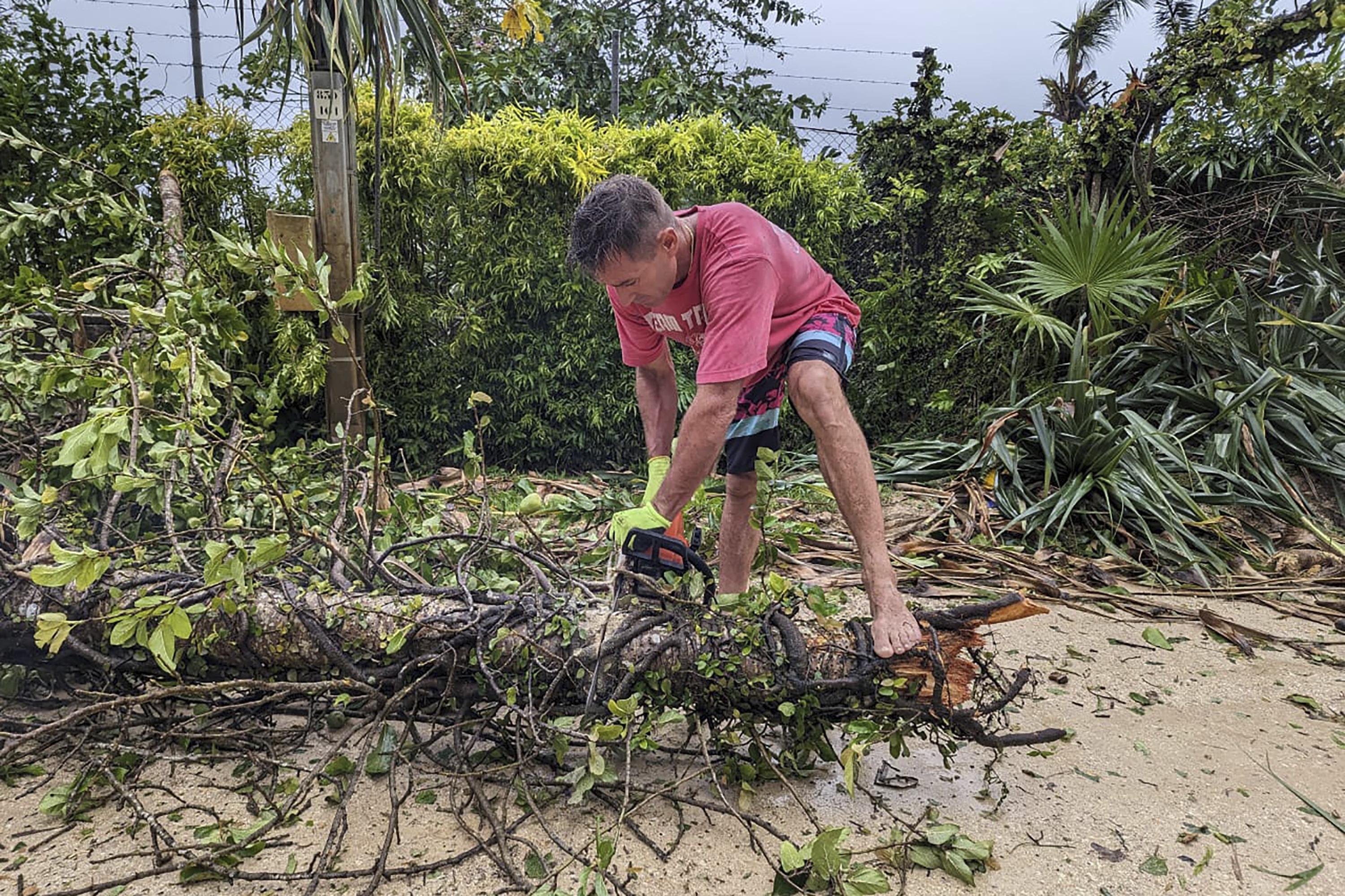 Children walk outside beachfront houses threatened by coastal erosion in the town of Veivatuloa, Fiji, in December. The country has been preparing meticulously for the day it needs to relocate coastal villages because of climate change. (PHOTO / AFP)
Children walk outside beachfront houses threatened by coastal erosion in the town of Veivatuloa, Fiji, in December. The country has been preparing meticulously for the day it needs to relocate coastal villages because of climate change. (PHOTO / AFP)
Islanders across the Pacific Ocean are watching their homes and way of life slowly disappear as seawater levels rise and saltwater turns once-clean drinking water into brine.
These factors, brought about by climate change, are having an impact on water and food security, and the region's fragile biodiversity and culture.
Pacific island nations are not industrial powerhouses, but they experience the full impact of climate change by default, as outlined recently in the 2023 Asia-Pacific SDG Progress Report of the UN Economic and Social Commission for Asia and the Pacific, or ESCAP.
The body, which is based in Bangkok, said that at the current pace, the Asia-Pacific region will miss all or most of the climate targets outlined in the Sustainable Development Goals, or SDGs.
"Progress toward climate action is slipping away. The region is both a victim of the impact of climate change and a perpetrator of climate change," the report said.
The World Risk Index published by Ruhr University Bochum in Germany said that of all the regions in the world, the Pacific has the highest risk from climate change due to "high exposure to extreme natural events".The risk is not only a question of exposure to climate change, but also a lack of adaptation to such change.
The Index states: "This underscores the very real challenge that climate change presents to the Pacific and the importance of focusing on developing sustainable growth that utilizes local resources, especially the resources of the Pacific Ocean, for development."
Sangmin Nam, director of ESCAP's Environment and Development Division, said greenhouse gas, or GHG, emissions in the Asia-Pacific region rose by 25 percent from 2010 to 2019, or more than 100 percent from the levels in 1990.
"This trend results in the region sharing more than half of the global emissions and continuing to expand the global share," he said. "The major sources of GHG emissions in the region are electricity and heating, manufacturing and construction, and transportation."
He said electricity and heating account for the bulk of energy emissions in the region, and 38 percent of total emissions, which is higher than emissions from electricity and heating in the rest of the world.
"Carbon dioxide emissions from transportation in the region have risen by more than 200 percent over the past three decades. … The region's share of global transportation emissions has also risen, from 14 percent to 27 percent, from 1990 to 2018," he said.
 A chainsaw is used on a fallen tree in Port Vila, Vanuatu, after a cyclone swept through the Pacific island nation in March. (PHOTO / AP)
A chainsaw is used on a fallen tree in Port Vila, Vanuatu, after a cyclone swept through the Pacific island nation in March. (PHOTO / AP)
However, many sectoral trends regarding climate change are now being reversed. "There is a positive sign," he added.
"During the past three years, about 80 percent of Asia-Pacific countries announced carbon neutrality or net zero targets, showing the increasing readiness of countries to start deep emissions reduction sooner than initially planned."
In Papua New Guinea, Jacob Ekinye, adaptation and project division manager of the Climate Change and Development Authority, said climate change is an ongoing issue and it will take time and effort for local people to cope with climate impact.
He was speaking at a media conference while presenting Papua New Guinea's 2022-30 National Adaptation Plan, which addresses priority areas, such as warning systems, awareness and education for communities.
"The National Adaptation Plan, a way forward for Papua New Guinea to cope with climate change, is intended to enhance adaptive capacities, increase resilience and reduce the level of vulnerability to the adverse effects of climate change felt by our people," Ekinye was quoted as saying last month by Papua New Guinea newspaper The National.
A lack of safe drinking water is another persistent problem for the nation. Borehole supply is one of the options to address this problem in the nation's capital Port Moresby, the PNG Post-Courier, another newspaper based in the city, reported.
At a recent water event in Port Moresby, National Capital District Governor Powes Parkop was quoted by Post-Courier Online as saying: "Water, as we all know, is still a big issue in the city. I have been here 16 years and I cannot solve it."
In December, the Chinese embassy in Port Moresby donated new laptops to the Climate Change and Development Authority of Papua New Guinea.
The Intergovernmental Panel on Climate Change has said that vulnerable communities, such as those in the Pacific, who have historically contributed the least to current climate change are disproportionately affected by it.
Rachael Beaven, director of ESCAP's Statistics Division, said the Asia-Pacific region is home to six of the top 10 global carbon emitters, contributing to more than half the world's total greenhouse gases. It is also highly vulnerable to climate-induced disasters and extreme weather events.
She said ESCAP estimates the region's annual losses due to climate-induced disasters at $675 billion, with disproportionate impacts on the most vulnerable groups — many of them living in the region.
Wesley Morgan, a senior researcher for the Climate Council, a climate research organization based in Australia, said, "Pacific island countries have been crystal clear for decades that climate change is their greatest security threat.
"Compared with geostrategic competition, the impacts of a warming planet — stronger cyclones, devastating floods, rising seas and dying reefs — are more immediate threats," he said in a commentary in July for the academic website The Conversation.
karlwilson@chinadailyapac.com